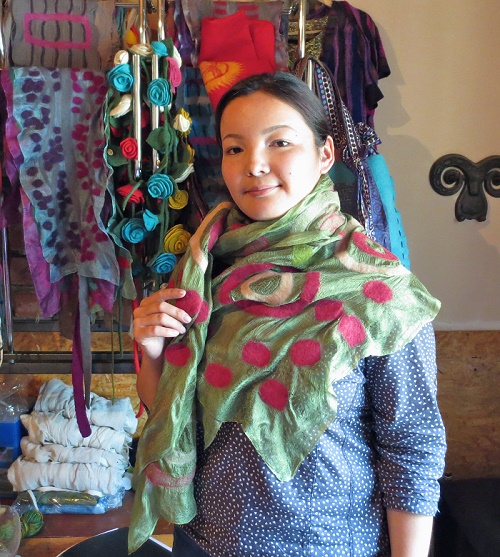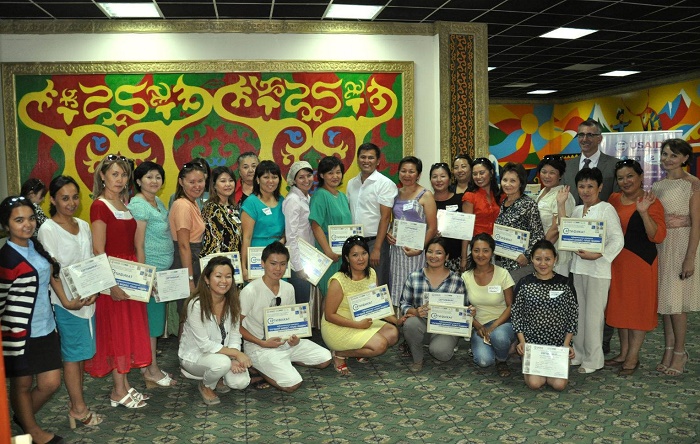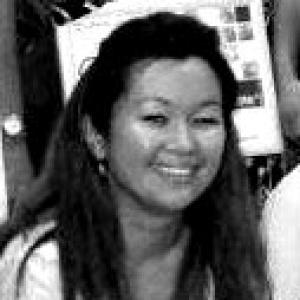The Use of Nonfinancial Services to Help Grow Women's Leadership in SMEs: The Kyrgyzstan Case
Introduction
Who: ACDI/VOCA and Bai Tushum Fund (BT Fund)
When: September 2012 - 2015
What: ACDI/VOCA and BT Fund have partnered to target high-potential women entrepreneurs who own small and medium enterprises (SMEs).
Where: The Kyrgyz Republic
Why: Previous experience has shown that increased access to finance is necessary but not sufficient for women entrepreneurs to grow their businesses.
How: To address this realization, BT Fund and other investors formed Bai Tushum Bank, a women-led microfinance institution that aims to help women build their businesses through a more integrated approach.
 The WLSME-Kyrgyzstan beneficiaries are women entrepreneurs who operate enterprises in “priority sectors” and have at least one non-family member employee (but preferably around five employees). To identify the three priority sectors from which participants were recruited, the ACDI/VOCA enterprise development experts and WLSME program team conducted a rapid market assessment from December 2012 to February 2013. This assessment revealed that the garment, tourism, and agro-processing sectors offered unique opportunities for WLSME intervention.
The WLSME-Kyrgyzstan beneficiaries are women entrepreneurs who operate enterprises in “priority sectors” and have at least one non-family member employee (but preferably around five employees). To identify the three priority sectors from which participants were recruited, the ACDI/VOCA enterprise development experts and WLSME program team conducted a rapid market assessment from December 2012 to February 2013. This assessment revealed that the garment, tourism, and agro-processing sectors offered unique opportunities for WLSME intervention.
Theory of Change
Our project seeks to reduce barriers to human capital, social capital, and business information that limit the growth of women’s enterprises. It does so by building management capacity as well as providing targeted training and technical assistance to current business owners who have the potential to grow their microbusinesses to reach the status of a small or medium-sized enterprise (SME).
Our program aims to test two hypotheses:
- That delivering nonfinancial services which increase women’s human capital, social capital, and access to market information will increase the number of women who start up or grow SMEs.
- That this growth, in turn, will increase the demand for, and provision of, financial services to women-led SMEs.
Testing these hypotheses will demonstrate whether the nonfinancial constraints on Kyrgyz women entrepreneurs are binding and whether access to finance can be improved through the provision of nonfinancial services.
Project activities were sequenced and grew increasingly more specialized. At the outset, we delivered standard business training services to roughly 750 clients. As we developed more tailored and specialized activities, fewer women were targeted until finally the 100 most promising women entrepreneurs received the most intensive mentoring and skills-development activities.
One of our major objectives has been to build the social capital of women business owners through better linkages with each other, key industry associations, and other businesses (larger, smaller, male-owned, and women-owned). To this end, we organized regional networking events for women entrepreneurs with various potential stakeholders, such as banks, advisory centers, the taxation agency, the patent office, etc. The idea was that – through these networks, forums, and relationships – women could establish market linkages, access important information about the market, build trust and create partnerships, learn from each other, advocate for issues of importance, and be encouraged in their business pursuits.
Successes
We implemented a series of recruitment/advocacy meetings throughout the provinces of Kyrgyzstan. During the meetings, we presented the program and responded to women’s questions. We also used other methods of recruitment, such as TV and radio announcements, newspaper adverts, and personal references; nevertheless, we recruited the highest number of participants through the meetings.
Key Constraints
Women entrepreneurs are busy. They lack time to participate in training activities. Recognizing this challenge, we adjusted the duration, delivery mode, and methodology of training in order to suit the needs of women entrepreneurs. All training seminars were short (2-3 days at most) with:
- Flexible timing of 2-6 hours per day;
- An emphasis on highly practical business cases rather than theory; and
- Many interactive exercises (based on adult learning methods) that could be immediately adapted to the women’s businesses.
Attendance and retention rates are difficult to sustain if the development intervention is not suited to women’s particular needs. We identified these three factors as key to ensuring higher rates of success:
- Providing greater flexibility;
- Adapting to women’s needs; and
- Providing every woman entrepreneur with an individualized focus.
Lessons Learned
One of our most important lessons has been that increasing the involvement of husbands and families in training and support activities helps to improve outcomes. We learned that women are often inspired to incorporate new changes in their businesses as a result of WLSME training and consultation, but they still face a lack of support from their husbands and families. Letting husbands join some training sessions sensitizes them thereby creating a favorable environment for women and their families.
We invited husbands to join exchange visits, and the result was highly positive. Women entrepreneurs talked about receiving increased support from their husbands. While we came upon this insight relatively late (in the third year of implementation), we would recommend involving families more in future programming.
Next Steps
Until September 2015, we are implementing activities for the final group of 100 women entrepreneurs with the highest growth potential. The work includes:
- Mentorship
- Exchange visits between enterprises
- Individual tailored consultations
- Technical training
- A small investment fund to ameliorate the costs of upgrading the enterprises
Mentorship
Mentorship support is being provided to the 27 winners of the business plan competition. Mentors are experienced entrepreneurs in the industries where the WLSME mentees run their businesses. Mentorship involves regular meetings between mentors and mentees (at least once every two weeks) for eight weeks. The content and structure of the meetings are left to be decided between mentors and mentees.
Exchange Visits
Exchange visits are being delivered for tourism and textile sector participants of the program who were winners of the business plan competition. Exchange visits are trips to champion enterprises in the textile or tourism sectors. These visits bring together a group of 8-10 women entrepreneurs who go and visit several bigger and successful enterprises (usually in Bishkek) for 2-3 days.
Tailored Technical Advice
 Tailored technical advice is offered to 20+ winners of WLSME’s business plan competition. These women are provided with seven days of individual consultation by international and/or national consultants. The areas of support have thus far focused on the following issues:
Tailored technical advice is offered to 20+ winners of WLSME’s business plan competition. These women are provided with seven days of individual consultation by international and/or national consultants. The areas of support have thus far focused on the following issues:
- Quality standards of garment products and their compatibility with the export requirements to Customs Union countries (Russia, Belarus, Kazakhstan, Kyrgyzstan)
- Marketing of Kyrgyz handmade products to the US and Canadian markets;
- Quality and hygiene standards for agro-processed products; and
- Marketing of hotels on global online platforms.
Technical Training Sessions
Technical training is offered to the 80 winners of the business plan competition. Technical session topics include training on hospitality management for small hotels and guest houses, design and modelling for the textile sector, and canning and processing methods for the agriculture sector.
All in all, a number of lessons learned have emerged from the WLSME Kyrgyzstan project, with further insights and results to come. Read more about WLSME Kyrgyzstan activities, such as the market assessment, on www.wlsme.kg, and be sure to watch the below video to learn about a participant's experience in the WLSME Kyrgyzstan program.
This project is one of three awarded under the USAID-funded WLSME program. Learn more about USAID’s WLSME initiative.


